Adlard E.R. (ed.) Chromatography in the Petroleum Industry
Подождите немного. Документ загружается.

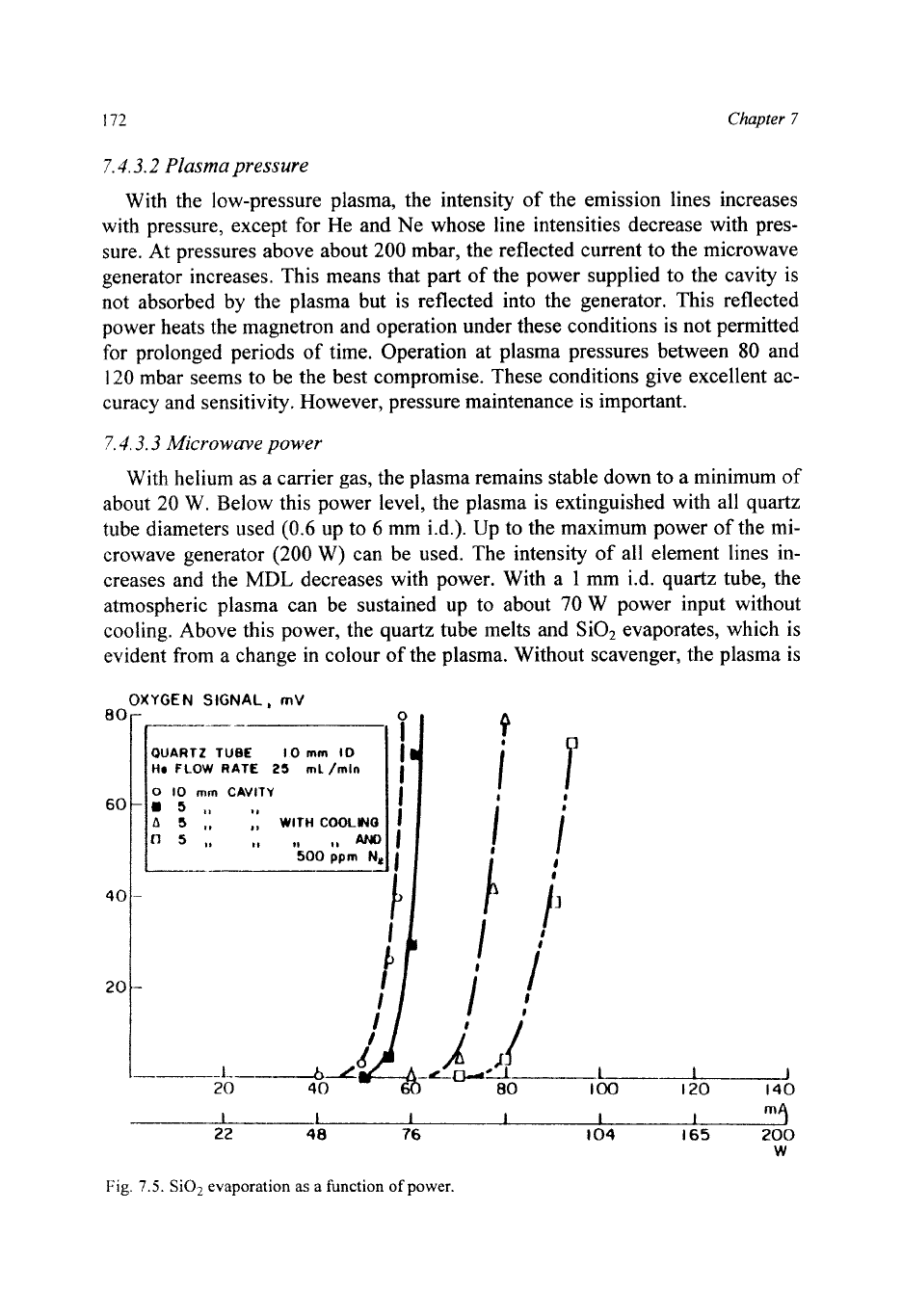
172
Chapter
7
7.4.3.2
Plasma
pressure
With the low-pressure plasma, the intensity
of
the emission lines increases
with pressure, except
for
He and Ne whose line intensities decrease with pres-
sure. At pressures above about
200
mbar, the reflected current to the microwave
generator increases. This means that part
of
the power supplied to the cavity is
not absorbed by the plasma but is reflected into the generator. This reflected
power heats the magnetron and operation under these conditions
is
not permitted
for
prolonged periods
of
time. Operation at plasma pressures between
80
and
120
mbar seems to be the best compromise. These conditions give excellent ac-
curacy and sensitivity. However, pressure maintenance is important.
7.4.3.3
Microwave power
With helium as a carrier gas, the plasma remains stable down to a minimum
of
about
20
W. Below this power level, the plasma is extinguished with all quartz
tube diameters used
(0.6
up to
6
mm i.d.). Up to the maximum power
of
the mi-
crowave generator
(200
W) can be used. The intensity
of
all element lines in-
creases and the
MDL
decreases with power. With a
1
mm i.d. quartz tube, the
atmospheric plasma can be sustained up to about
70
W
power input without
cooling. Above this power, the quartz tube melts and Si02 evaporates, which is
evident fiom a change in colour
of
the plasma. Without scavenger, the plasma is
OXYGEN
SIGNAL,
mV
QUARTZ TUBE
10
mm
ID
HI
FLOW
RATE
25
ml/mln
I
1
I
I
m
I1
22
48
76
I04
I65
200
W
Fig.
7.5.
SOz
evaporation as a
function
of
power.
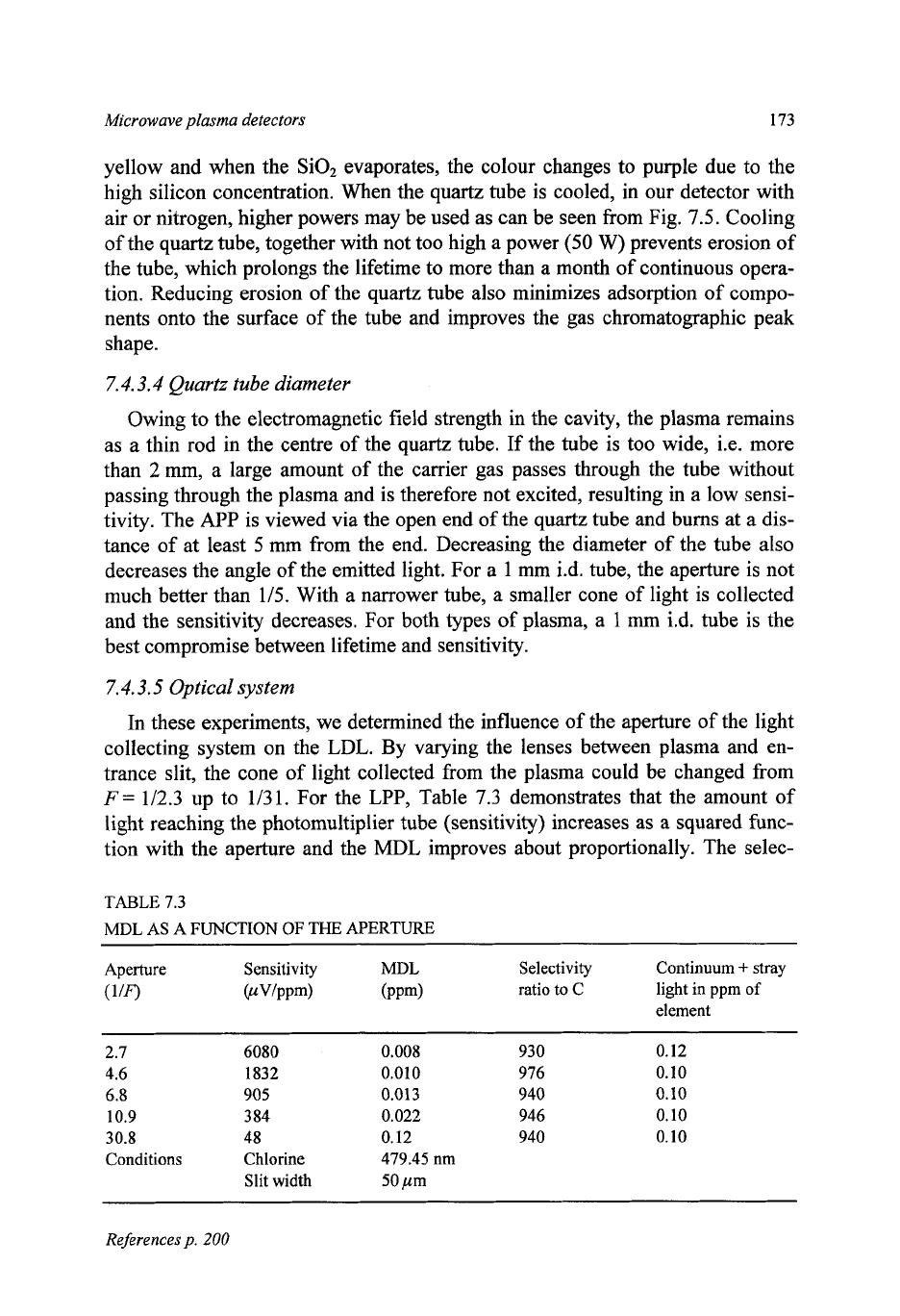
Microwave
plasma
detectors
173
yellow and when the SiOz evaporates, the colour changes to purple due to the
high silicon concentration. When the quartz tube is cooled, in our detector with
air or nitrogen, higher powers may be used as can be seen from Fig. 7.5. Cooling
of
the quartz tube, together with not too high a power (50 W) prevents erosion of
the tube, which prolongs the lifetime to more than a month of continuous opera-
tion. Reducing erosion
of
the quartz tube also minimizes adsorption
of
compo-
nents onto the surface of the tube and improves the gas chromatographic peak
shape.
7.4.3.4 Quartz tube diameter
Owing to the electromagnetic field strength in the cavity, the plasma remains
as a thin rod in the centre
of
the quartz tube.
If
the tube is too wide, i.e. more
than
2
mm, a large amount
of
the carrier gas passes through the tube without
passing through the plasma and is therefore not excited, resulting in a low sensi-
tivity. The
APP
is viewed via the open end
of
the quartz tube and burns at a dis-
tance
of
at least
5
mm from the end. Decreasing the diameter of the tube also
decreases the angle of the emitted light. For a
1
mm id. tube, the aperture is not
much better than 1/5. With a narrower tube, a smaller cone
of
light is collected
and the sensitivity decreases. For both types of plasma, a
1
mm
i.d. tube is the
best compromise between lifetime and sensitivity.
7.4.3.5
Optical
system
In
these experiments, we determined the influence
of
the aperture
of
the light
collecting system on the LDL. By varying the lenses between plasma and en-
trance slit, the cone
of
light collected from the plasma could be changed from
F=
U2.3 up to 1/31. For the
LPP,
Table 7.3 demonstrates that the amount
of
light reaching the photomultiplier tube (sensitivity) increases as
a
squared func-
tion with the aperture and the MDL improves about proportionally. The selec-
TABLE
7.3
MDL
AS
A
FUNCTION OF THE
APERTURE
Aperture
Sensitivity
MDL Selectivity Continuum
+
stray
(1/F)
OIV/PPm)
(PPm) ratio
to
C
light in ppm
of
element
2.7 6080 0.008 930 0.12
4.6 1832
0.010
976
0.10
6.8 905
0.013
940
0.10
10.9
3
84 0.022 946 0.10
30.8 48 0.12 940 0.10
Conditions Chlorine
479.45
nm
Slit width
50
pm
Referencesp.
200
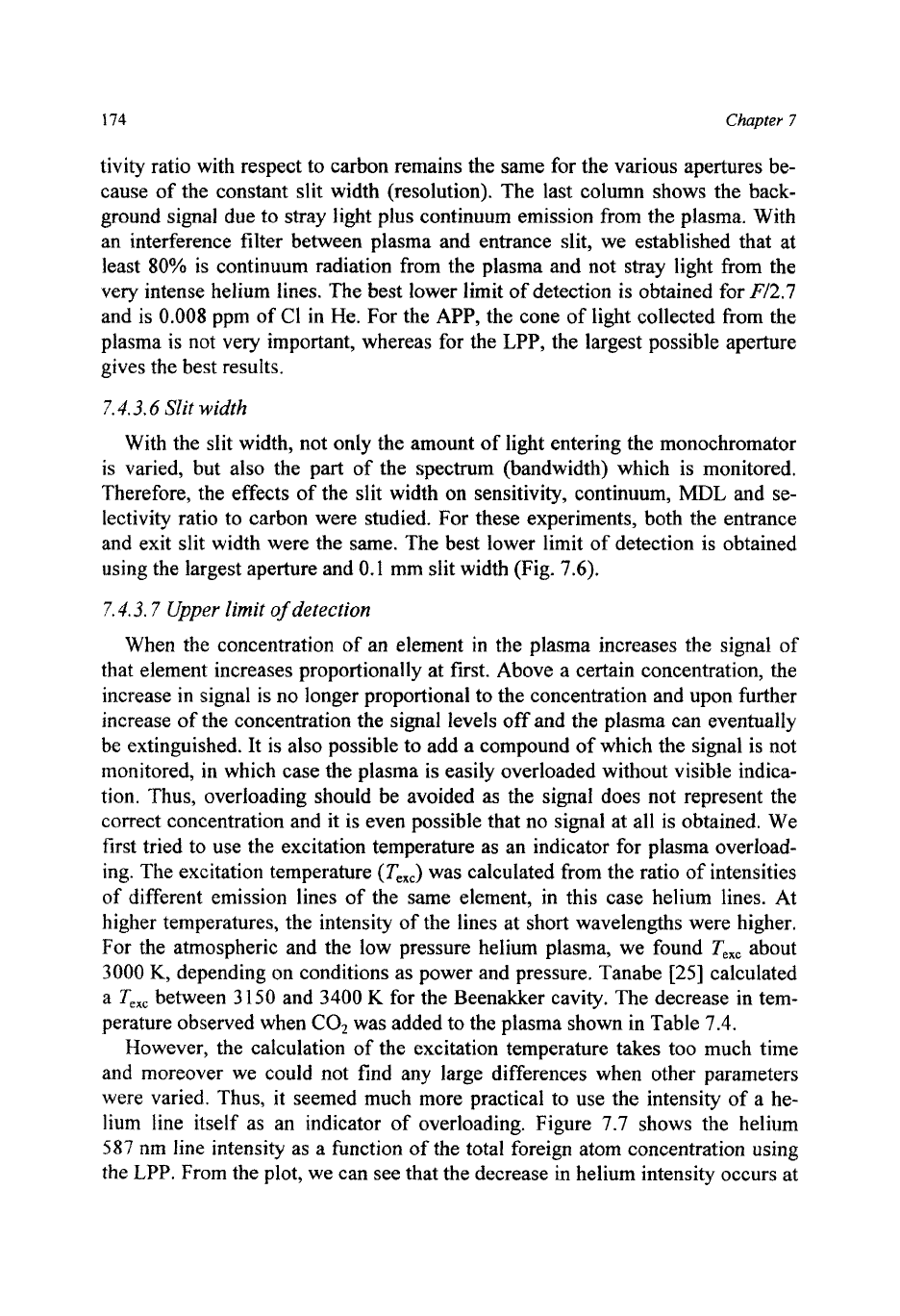
174
Chapter
7
tivity ratio with respect to carbon remains the same for the various apertures be-
cause of the constant slit width (resolution). The last column shows the back-
ground signal due to stray light plus continuum emission from the plasma. With
an interference filter between plasma and entrance slit, we established that at
least
80%
is continuum radiation from the plasma and not stray light from the
very intense helium lines. The best lower limit of detection is obtained for
F/2.7
and is
0.008
ppm of CI in He. For the APP, the cone of light collected from the
plasma is not very important, whereas for the LPP, the largest possible aperture
gives the best results.
7.4.3.6 Slit width
With the slit width, not only the amount of light entering the monochromator
is varied, but also the part of the spectrum (bandwidth) which is monitored.
Therefore, the effects of the slit width on sensitivity, continuum, MDL and se-
lectivity ratio to carbon were studied. For these experiments, both the entrance
and exit slit width were the same. The best lower limit of detection
is
obtained
using the largest aperture and
0.1
mm slit width (Fig.
7.6).
7.4.3.7
Upper
limit
of
detection
When the concentration
of
an element
in
the plasma increases the signal
of
that element increases proportionally at first. Above a certain concentration, the
increase
in
signal
is
no longer proportional to the concentration and upon further
increase of the concentration the signal levels
off
and the plasma can eventually
be extinguished. It is also possible to add
a compound of which the signal is not
monitored, in which case the plasma
is
easily overloaded without visible indica-
tion. Thus, overloading should be avoided
as
the signal does not represent the
correct concentration and it is even possible that no signal at all is obtained. We
first tried to use the excitation temperature as an indicator for plasma overload-
ing. The excitation temperature
(T',,)
was calculated from the ratio of intensities
of different emission lines of the same element, in this case helium lines. At
higher temperatures, the intensity of the lines at short wavelengths were higher.
For
the atmospheric and the low pressure helium plasma, we found
T,,,
about
3000
K,
depending on conditions as power and pressure. Tanabe
[25]
calculated
a
Text
between
3
150
and 3400
K
for the Beenakker cavity. The decrease in tem-
perature observed when
C02
was added to the plasma shown in Table
7.4.
However, the calculation of the excitation temperature takes too much time
and moreover we could not find any large differences when other parameters
were varied. Thus, it seemed much more practical to use the intensity of a he-
lium line itself as an indicator of overloading. Figure
7.7
shows the helium
587
nm line intensity as a function of the total foreign atom concentration using
the
LPP.
From the plot, we can see that the decrease in helium intensity occurs at
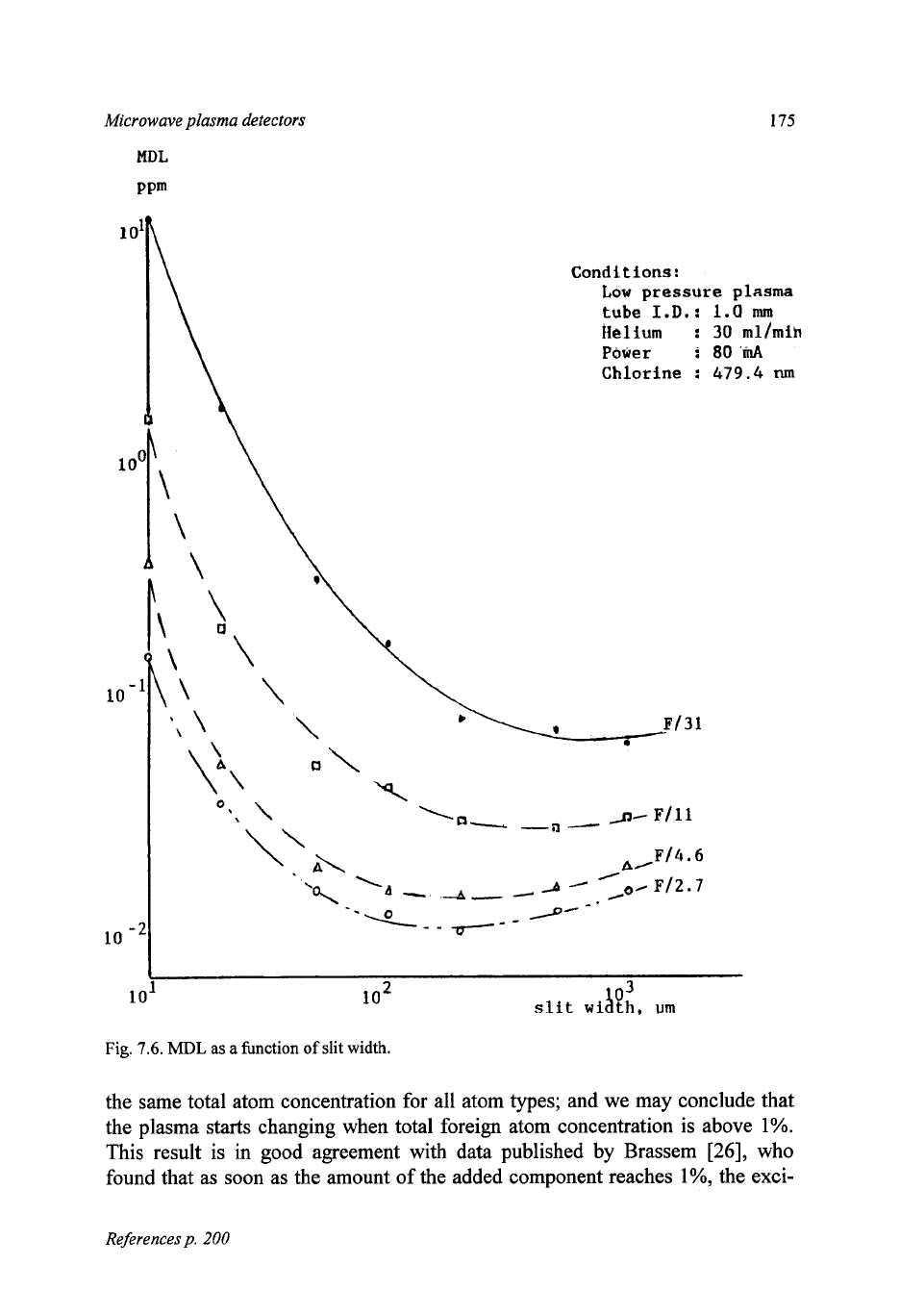
Microwave
plasma
detectors
MDL
PPm
175
Conditions:
Low
pressure
plasma
tube
I.D.:
l.Q
mm
Helium
:
30
ml/rnih
Pbwer
:
80
'iid
Chlorine
:
479.4
nm
I
lo1
lo2
Fig.
7.6.
MDL
as a
function
of
slit width.
the same total atom concentration for all atom types; and we may conclude that
the plasma starts changing when total foreign atom concentration is above
1%.
This result is in good agreement with data published by Brassem
[26],
who
found that as soon as the amount of the added component reaches
I%,
the exci-
References
p.
200
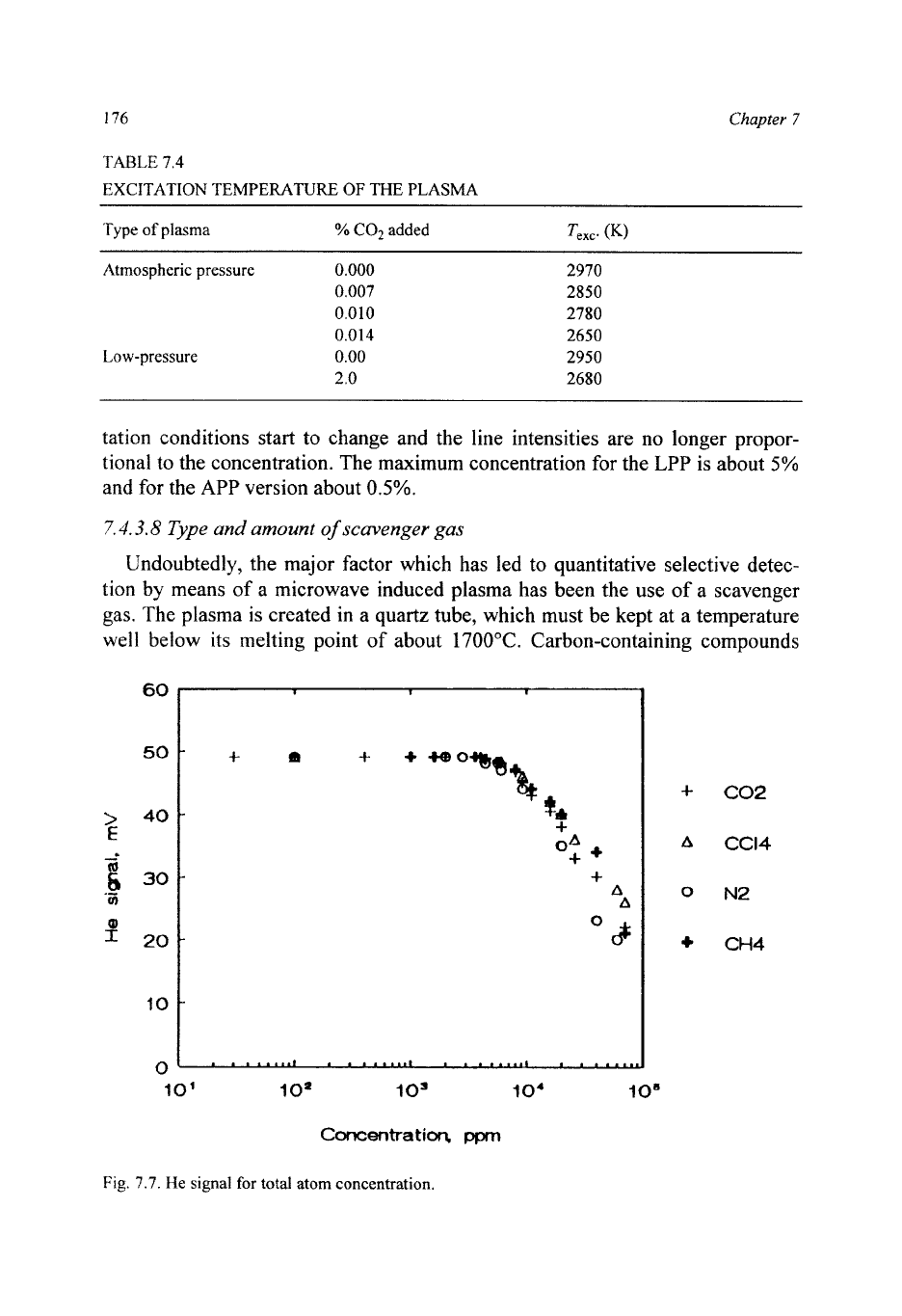
I76
Chapter
7
TABLE
7.4
EXCITATION
TEMPERATURE
OF
THE
PLASMA
Type
of
plasma
YO
COz
added
re,,.
(K)
Atmospheric pressure
0.000
2970
0.007 2850
0.010 2780
0.014 2650
Low-pressure
0.00
2950
2.0 2680
tation conditions start to change and the line intensities are
no
longer propor-
tional
to
the concentration. The maximum concentration for the
LPP
is
about
5%
and for the
APP
version about
0.5%.
7.4.3.8
Type
and amount
of
scavenger gas
Undoubtedly, the major factor which has led to quantitative selective detec-
tion by means of a microwave induced plasma has been the use
of
a scavenger
gas.
The plasma is created in a quartz tube, which must be kept at a temperature
well below its melting point
of
about 1700°C. Carbon-containing compounds
60
50
>
40
E
-
30
.-
rn
3
20
10
+
O*
++
+
A
A
O&
0
I
, ,
,
,,,..I
I
I
I
I
*..,I
I
I
I
.
.LU
10'
1
o*
10"
104
10"
Concentration
ppm
+
c02
A
cc14
0
N2
+
CH4
Fig.
7.7.
He signal
for
total
atom concentration.
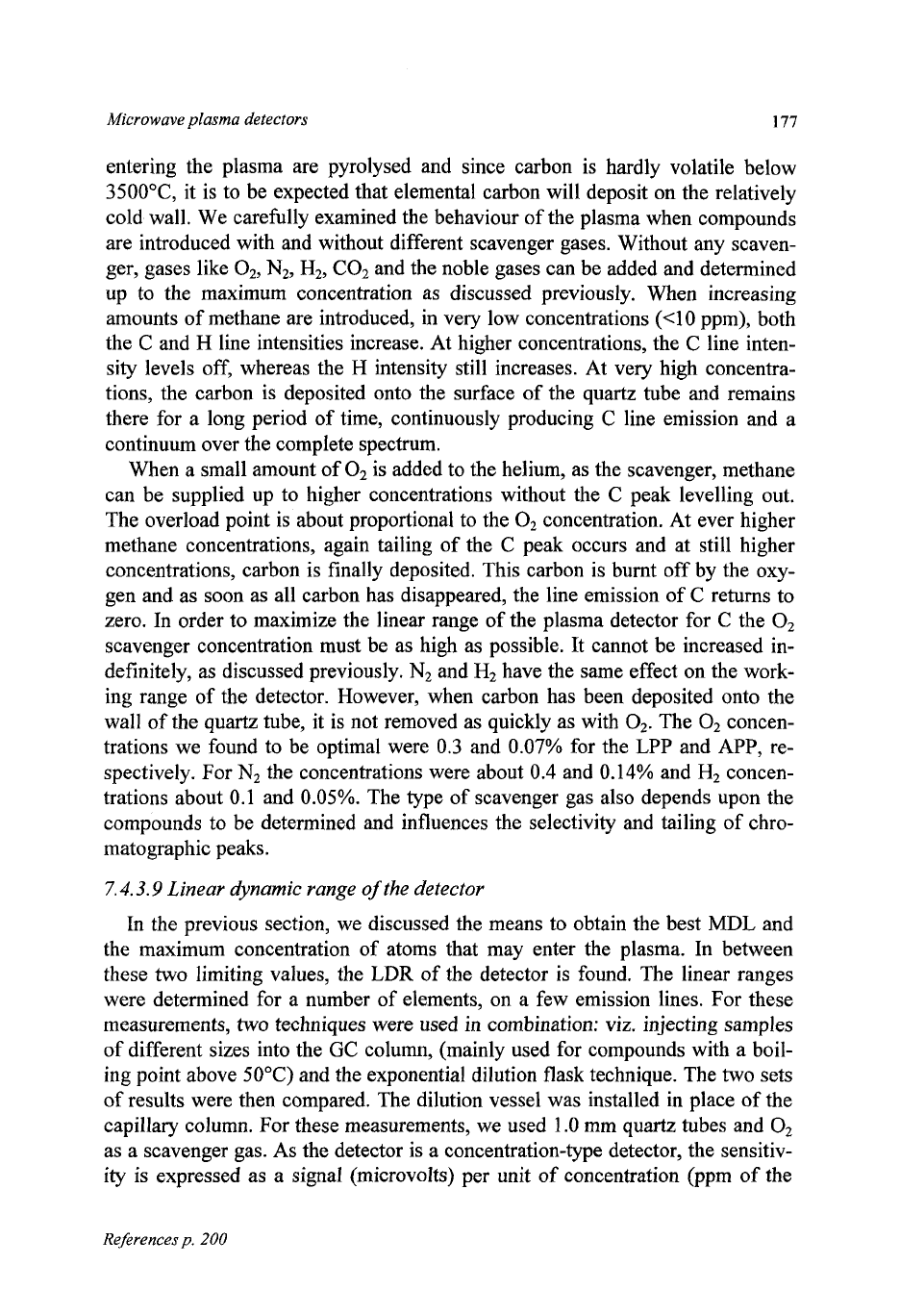
Microwave plasma detectors
177
entering the plasma are pyrolysed and since carbon is hardly volatile below
35OO0C,
it is to be expected that elemental carbon will deposit on the relatively
cold wall. We carefully examined the behaviour of the plasma when compounds
are introduced with and without different scavenger gases. Without any scaven-
ger, gases like
02,
N2,
H2,
C02 and the noble gases can be added and determined
up to the maximum concentration as discussed previously. When increasing
amounts
of methane are introduced, in very low concentrations
(40
ppm), both
the
C
and
H
line intensities increase. At higher concentrations, the
C
line inten-
sity levels off, whereas the
H
intensity still increases. At very high concentra-
tions, the carbon is deposited onto the surface of the quartz tube and remains
there for a long period of time, continuously producing
C
line emission and a
continuum over the complete spectrum.
When a small amount of
O2
is
added to the helium, as the scavenger, methane
can be supplied up to higher concentrations without the
C
peak levelling out.
The overload point is about proportional to the
O2
concentration. At ever higher
methane concentrations, again tailing
of the
C
peak occurs and at still higher
concentrations, carbon is finally deposited. This carbon
is
burnt off by the oxy-
gen and as soon as all carbon has disappeared, the line emission of
C
returns to
zero. In order to maximize the linear range of the plasma detector for
C
the
O2
scavenger concentration must be as high as possible. It cannot be increased in-
definitely,
as discussed previously.
N2
and
H2
have the same effect on the work-
ing range of the detector. However, when carbon has been deposited onto the
wall of the quartz tube, it is not removed as quickly as with
02.
The
O2
concen-
trations we found to be optimal were
0.3
and
0.07%
for the
LPP
and
APP,
re-
spectively. For
N2
the concentrations were about
0.4
and
0.14%
and
H2
concen-
trations about
0.1
and 0.05%. The type of scavenger gas also depends upon the
compounds to be determined and influences the selectivity and tailing of chro-
matographic peaks.
7.4.3.9
Linear dynamic range
of
the detector
In the previous section, we discussed the means to obtain the best
MDL
and
the maximum concentration of atoms that may enter the plasma. In between
these
two
limiting values, the
LDR
of the detector is found. The linear ranges
were determined for a number of elements, on a few emission lines. For these
measurements,
two techniques were used in combination: viz. injecting samples
of different sizes into the
GC
column, (mainly used for compounds with a boil-
ing point above 50°C) and the exponential dilution flask technique. The
two sets
of results were then compared. The dilution vessel was installed in place of the
capillary column. For these measurements, we used
1
.O
mm quartz tubes and O2
as a scavenger gas. As the detector is a concentration-type detector, the sensitiv-
ity is expressed as a signal (microvolts) per unit
of
concentration (ppm
of
the
References
p. 200
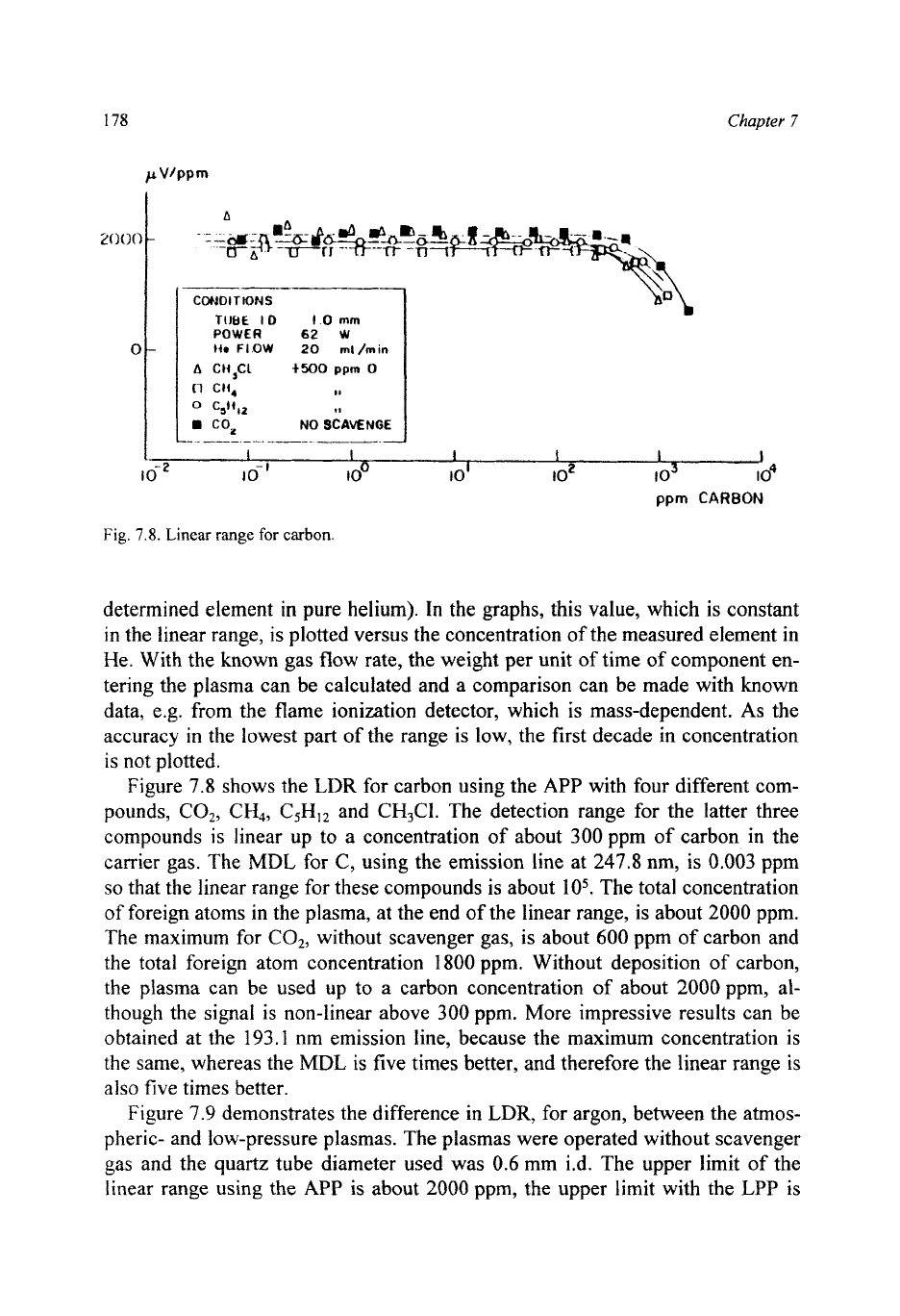
1'78
Chapter 7
I
1
I
I
I
I
I
lo-*
lo-'
loo
10'
lo2
lo3
lo4
ppm
CARBON
Fig.
'7.8.
Linear
range
for
carbon.
determined element in pure helium). In the graphs, this value, which is constant
in
the linear range, is plotted versus the concentration of the measured element in
He. With the known gas flow rate, the weight per unit of time of component en-
tering the plasma can be calculated and
a
comparison can be made with known
data, e.g. from the flame ionization detector, which is mass-dependent.
As
the
accuracy in the lowest part of the range
is
low, the first decade in concentration
is
not
plotted.
Figure
7.8
shows the
LDR
for carbon using the
APP
with four different com-
pounds, COz,
Cfi,
C5H,, and CH,CI. The detection range for the latter three
compounds
is
linear up to a concentration of about
300
ppm of carbon in the
carrier gas. The MDL for C, using the emission line at
247.8
nm, is
0.003
ppm
so
that the linear range for these compounds is about
lo5.
The total concentration
of foreign atoms in the plasma, at the end of the linear range, is about 2000 ppm.
The maximum for CO,, without scavenger gas,
is
about
600
ppm of carbon and
the total foreign atom concentration
1800
ppm. Without deposition of carbon,
the plasma can be used up to a carbon concentration
of
about 2000ppm, al-
though the signal is non-linear above
300
ppm. More impressive results can be
obtained at the
193.1
nm emission line, because the maximum concentration is
the same, whereas the MDL is five times better, and therefore the linear range
is
also five times better.
Figure
7.9
demonstrates the difference in
LDR,
for argon, between the atmos-
pheric- and low-pressure plasmas. The plasmas were operated without scavenger
gas and the quartz tube diameter used was
0.6
mm i.d. The upper limit of the
linear range using the
APP
is
about
2000
ppm, the upper limit with the
LPP
is
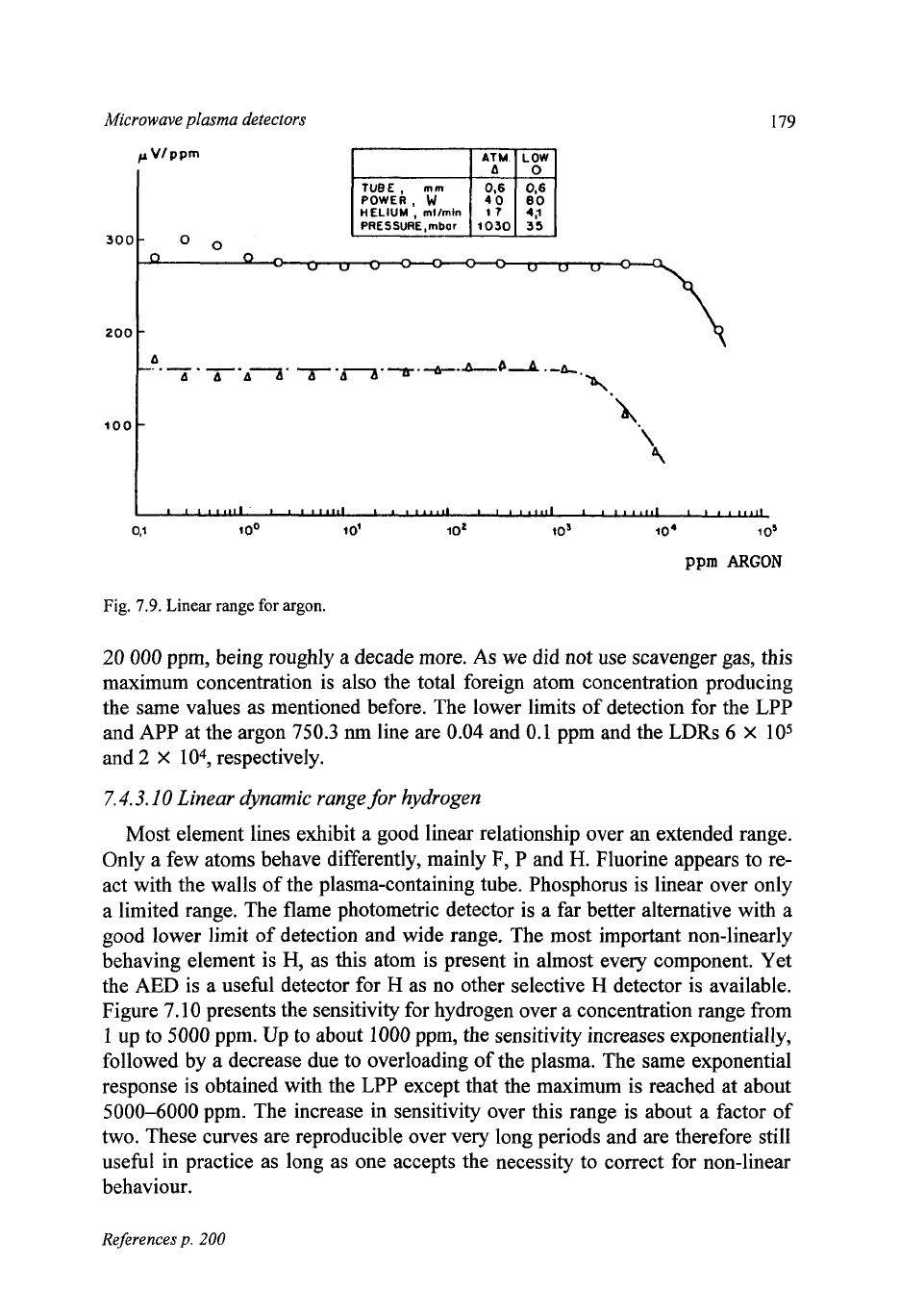
Microwave
plasma
detectors
pVlvPm
179
Fig.
7.9.
Linear range for argon.
20
000
ppm, being roughly a decade more.
As
we did not use scavenger gas, this
maximum concentration is also the total foreign atom concentration producing
the same values as mentioned before. The lower limits
of
detection for the LPP
and APP at the argon 750.3 nm line are
0.04
and
0.1
ppm and the
LDRs
6
X
lo5
and
2
X
104,
respectively.
7.4.3.10
Linear dynamic range for hydrogen
Most element lines exhibit a good linear relationship over
an
extended range.
Only a few atoms behave differently, mainly
F,
P and
H.
Fluorine appears to re-
act with the walls of the plasma-containing tube. Phosphorus is linear over only
a limited range. The flame photometric detector is a far better alternative with a
good lower limit
of
detection and wide range, The most important non-linearly
behaving element is
H,
as this atom is present in almost every component. Yet
the
AED
is a useful detector for
H
as no other selective
H
detector is available.
Figure 7.10 presents the sensitivity for hydrogen over a concentration range from
1
up to 5000 ppm. Up to about
1000
ppm, the sensitivity increases exponentially,
followed by a decrease due to overloading of the plasma. The same exponential
response is obtained with the LPP except that the maximum is reached at about
5000-6000 ppm. The increase in sensitivity over this range is about a factor of
two. These curves are reproducible over very long periods and are therefore still
useful in practice
as
long as one accepts the necessity to correct for non-linear
behaviour.
References
p.
200
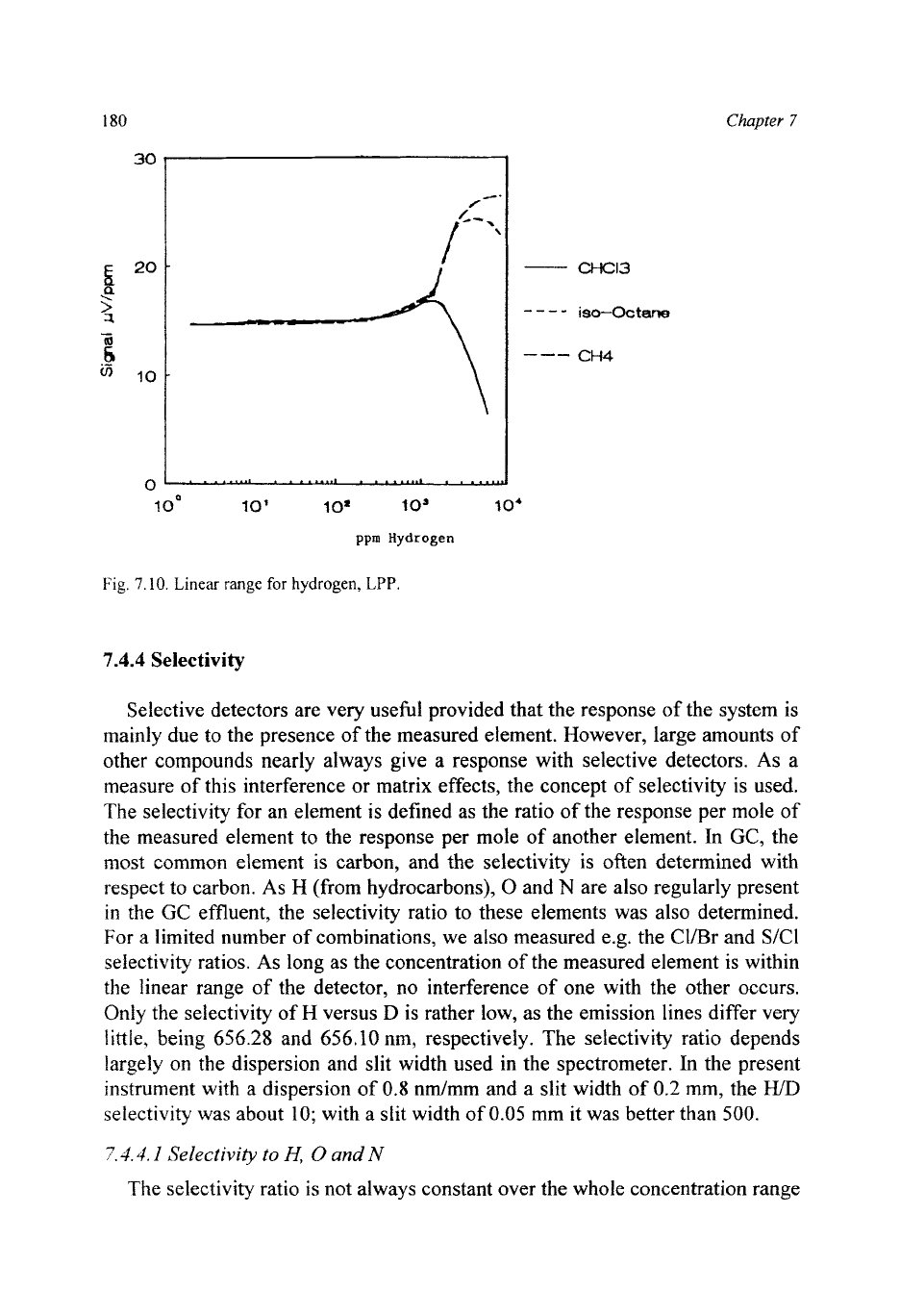
180
30
!i
2o
z
;
a
-
3
10
0
"
1
oa
10'
10'
10'
1
o4
ppm
Hydrogen
Chapter
7
-
CHC13
iso-Oc
term
cH4
-___
---
Fig.
7.10.
Linear range
for
hydrogen,
LPP.
7.4.4
Selectivity
Selective detectors are very useful provided that the response of the system is
mainly due to the presence of the measured element. However, large amounts of
other compounds nearly always give a response with selective detectors. As a
measure of this interference
or
matrix effects, the concept of selectivity is used.
The selectivity for an element is defined as the ratio of the response per mole of
the measured element to the response per mole of another element. In GC, the
most common element
is
carbon, and the selectivity is often determined with
respect to carbon.
As
H
(from hydrocarbons),
0
and
N
are also regularly present
in
the GC effluent, the selectivity ratio to these elements was also determined.
For
a limited number
of
combinations, we also measured e.g. the ClBr and
SKI
selectivity ratios.
As
long as the concentration of the measured element is within
the linear range of the detector,
no
interference of one with the other occurs.
Only the selectivity
of
H
versus
D
is rather low, as the emission lines differ very
little, being
656.28
and
656.10
nm, respectively. The selectivity ratio depends
largely on the dispersion and slit width used in the spectrometer. In the present
instrument with a dispersion
of
0.8
ndmm and a slit width of
0.2
mm, the
H/D
selectivity was about
10;
with a slit width of
0.05
mm it was better than
500.
74.4.
I
Selectivity
to
H,
0
and
N
The selectivity ratio is not always constant over the whole concentration range
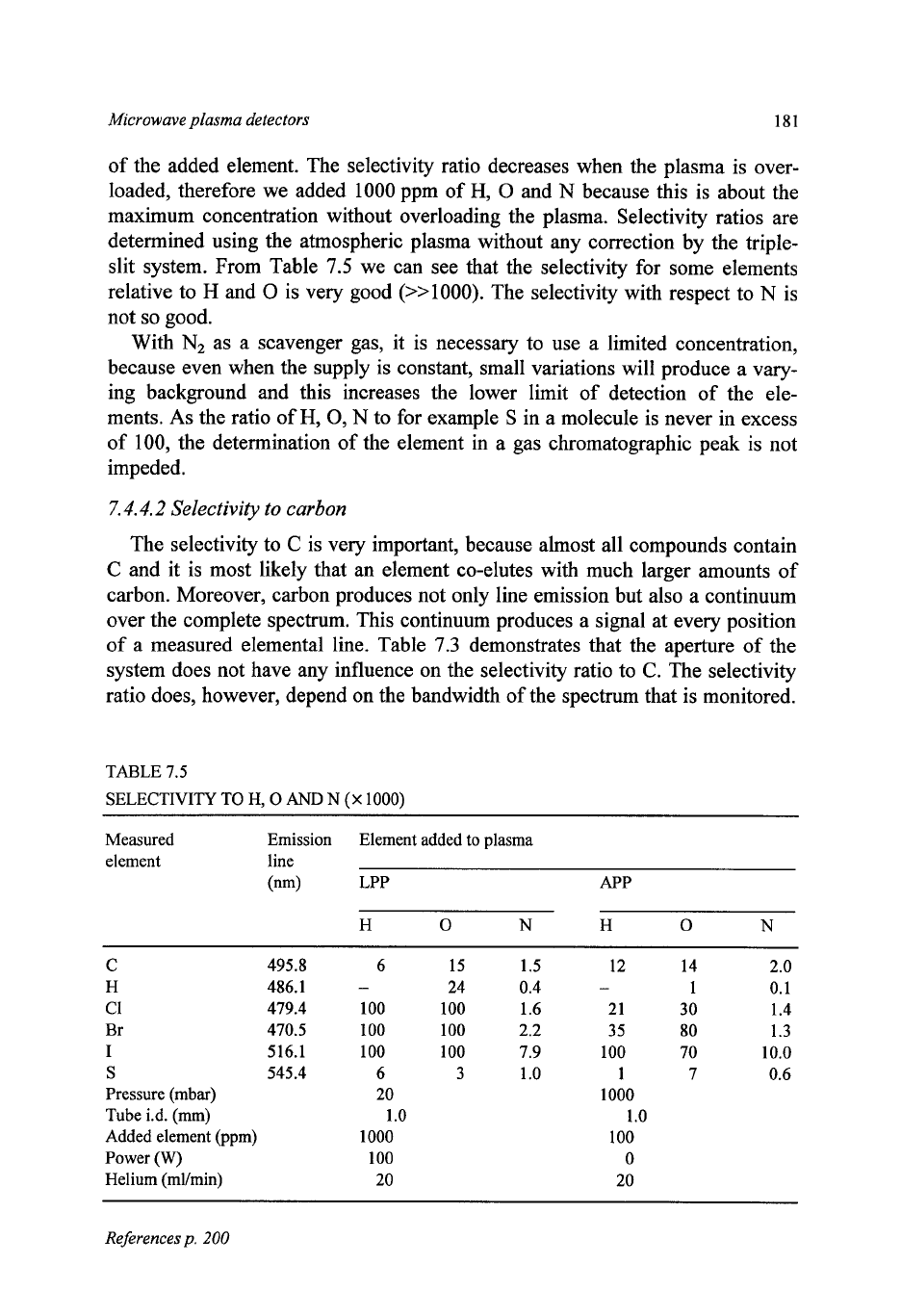
Microwave plasma detectors
181
of
the added element. The selectivity ratio decreases when the plasma is over-
loaded, therefore we added
1000
ppm of
H,
0
and
N
because this is about the
maximum concentration without overloading the plasma. Selectivity ratios are
determined using the atmospheric plasma without any correction by the triple-
slit system. From Table
7.5
we can see that the selectivity for some elements
relative to
H
and
0
is very good
(>>lOOO).
The selectivity with respect to
N
is
not
so
good.
With
N2
as a scavenger gas, it is necessary to use a limited concentration,
because even when the supply is constant, small variations will produce a vary-
ing background and this increases the lower limit of detection
of
the ele-
ments.
As
the ratio of
H,
0,
N
to for example
S
in
a
molecule is never in excess
of
100,
the determination of the element in
a
gas chromatographic peak is not
impeded.
7.4.4.2
Selectivig to carbon
The selectivity to
C
is very important, because almost all compounds contain
C
and it is most likely that an element co-elutes with much larger amounts
of
carbon. Moreover, carbon produces not only line emission but also a continuum
over the complete spectrum. This continuum produces a signal at every position
of a measured elemental line. Table
7.3
demonstrates that the aperture of the
system does not have any influence on the selectivity ratio to
C.
The selectivity
ratio does, however, depend on the bandwidth of the spectrum that is monitored.
TABLE
7.5
SELECTIVITY
TO H,
0
AND N
(X
1000)
Measured Emission Element added to plasma
element line
(nm) LPP APP
H
0
N
H
0
N
C
495.8
6 15
H
486.1
-
24
c1
479.4 100 100
Br
470.5
100
100
I
516.1 100 100
S
545.4
6 3
Pressure (mbar)
20
Tube i.d. (mm)
1
.o
Added element (ppm)
1000
Power
(W)
100
Helium (ml/min)
20
1.5 12 14 2.0
0.4
-
1
0.1
1.6 21 30 1.4
2.2 35
80
1.3
7.9 100 70 10.0
1
.o
1 7 0.6
1000
1
.o
100
0
20
References p.
200
